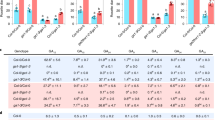Abstract
THE difference in growth rate of the two sides of geotropically reacting plant organs is generally explained by the well documented unequal auxin concentrations in the two halves. The auxin ratio in horizontally placed stems, coleoptiles, and roots usually attains a value of about 2:1 in favour of the lower half.
This is a preview of subscription content, access via your institution
Access options
Subscribe to this journal
Receive 51 print issues and online access
$199.00 per year
only $3.90 per issue
Buy this article
- Purchase on Springer Link
- Instant access to full article PDF
Prices may be subject to local taxes which are calculated during checkout
Similar content being viewed by others
References
Phillips, I. D. J., Planta, 105, 234–244 (1972).
Railton, I. D., and Phillips, I. D. J., Planta, 109, 121–126 (1973).
Wilkins, M. B., in Gravity and the Organism (edit. by Gordon, S. A., and Cohen, M. J.) 107–121 (University of Chicago Press, Chicago and London, 1971).
Audus, L. J., in Gravity and the Organism (edit. by Gordon, S. A., and Cohen, M. J.), 137–149 (University of Chicago Press, Chicago and London, 1971).
Gibbons, G. S. B., and Wilkins, M. B., Nature, 226, 558–559 (1970).
Pilet, P.-E., Nature new Biol., 233, 115–116 (1971).
Pilet, P.-E., Planta, 111, 275–278 (1973).
Shaw, S., and Wilkins, M. B., Planta, 109, 11–26 (1973).
Lenton, J. R., Perry, V. M., and Saunders, P. F., Planta (Berl.), 96, 271–280 (1971).
Frankland, B., and Wareing, P. F., Nature, 185, 255–256 (1960).
Butcher, D. N., J. exp. Bot., 14, 272–280 (1963).
Carr, D. J., and Reid, D. M., in Biochemistry and Physiology of Plant Growth Substances (edit. by Wightman. F., and Setterfield, G.) 1169–1185 (Runge Press, Ottawa, 1968).
Jones, R. L., and Phillips, I. D. J., Pl. Physiol., 41, 1381–1386 (1966).
Cavell, B. D., MacMillan, J., Pryce, R. J., and Sheppard, A. C., Phytochemistry, 6, 867–874 (1967).
Pilet, P.-E., C. r. hebd. Séanc. Acad. Sci. Paris, 272, 418–421 (1971).
Richardson, S. D., Nature, 181, 429 (1958).
Butcher, D. N., and Street, H. E., J. exp. Bot., 11, 206–216 (1960).
El Hinnawy, E., Z. Pflrmzenphysiologie, 69, 1–12 (1973).
Abdalla, F. H., and El-Antably, H. M. M., Res. Bull. Fac. Agric. Ain Shams Univ., 697, 1–20 (Cairo, 1970).
Author information
Authors and Affiliations
Rights and permissions
About this article
Cite this article
EL-ANTABLY, H., LARSEN, P. Redistribution of endogenous gibberellins in geotropically stimulated roots. Nature 250, 76–77 (1974). https://doi.org/10.1038/250076a0
Received:
Revised:
Published:
Issue Date:
DOI: https://doi.org/10.1038/250076a0
This article is cited by
-
Kinetic studies on the redistribution of endogenous growth regulators in gravireacting plant organs
Planta (1983)
-
Nutation rhythm of growing pine hypocotyl (Pinus silvestris L.) interferred with a phototropic stimulus
Biologia Plantarum (1976)
-
Lateral movement of radioactivity from [14C]gibberellic acid (GA3) in roots and coleoptiles of Zea mays L. seedlings during geotropic stimulation
Planta (1974)
Comments
By submitting a comment you agree to abide by our Terms and Community Guidelines. If you find something abusive or that does not comply with our terms or guidelines please flag it as inappropriate.



